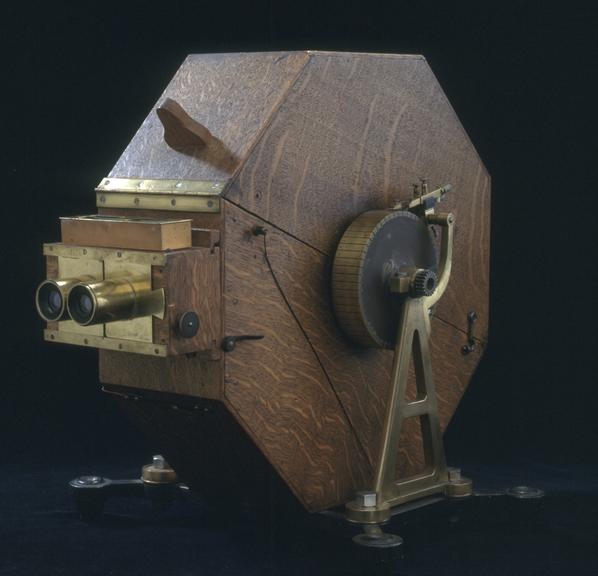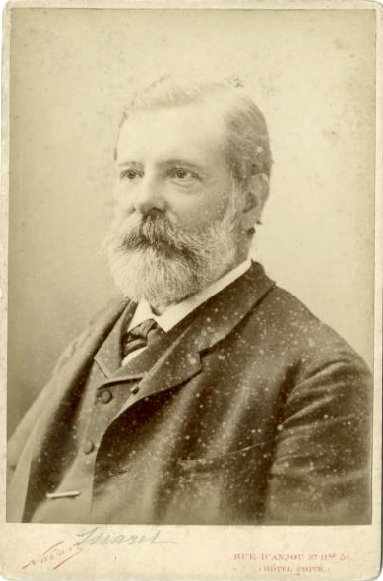|
Lucien Bull
Lucien Bull (January 5, 1876 – August 25, 1972) was a pioneer in chronophotography. Chronophotography is defined as "a set of photographs of a moving object, taken for the purpose of recording and exhibiting successive phases of motion." Early life Born in Dublin, Ireland to British father, Cornelius Bull, and French mother, Gabrielle Joune, Bull lived his younger years in Dublin where he attended school and lived at home with his parents. Later in 1894, Bull moved to France to visit his aunts. After several months, Bull eventually settled in the area and became an assistant to Étienne-Jules Marey in 1895. Marey was a physiologist interested in capturing human movement for later study. At the time, Marey was working on the cinematographic, which was a camera that was shaped like a rifle and took pictures of moving objects from a rotating plate. This eventually became known as the “gun camera”, a predecessor to the movie picture camera, which Bull later devised a faster ... [...More Info...] [...Related Items...] OR: [Wikipedia] [Google] [Baidu] |
Chronophotography
Chronophotography is a photographic technique from the Victorian era which captures a number of phases of movements. The best known chronophotography works were mostly intended for the scientific study of locomotion, to discover practical information for animal handlers and/or as reference material for artists. Although many results were not intended to be exhibited as moving pictures, there is much overlap with the more or less simultaneous quest to register and exhibit photographic motion pictures. Definition Chronophotography is defined as "a set of photographs of a moving object, taken for the purpose of recording and exhibiting successive phases of motion". The term ''chronophotography'' was coined by French physiologist Étienne-Jules Marey to describe photographs of movement from which measurements could be taken and motion could be studied. It is derived from the Greek word χρόνος '' chrónos'' ("time") combined with ''photography''.The J. Paul Getty Museum (1990). ... [...More Info...] [...Related Items...] OR: [Wikipedia] [Google] [Baidu] |
Dublin, Ireland
Dublin (; , or ) is the capital and largest city of Ireland. On a bay at the mouth of the River Liffey, it is in the province of Leinster, bordered on the south by the Dublin Mountains, a part of the Wicklow Mountains range. At the 2016 census it had a population of 1,173,179, while the preliminary results of the 2022 census recorded that County Dublin as a whole had a population of 1,450,701, and that the population of the Greater Dublin Area was over 2 million, or roughly 40% of the Republic of Ireland's total population. A settlement was established in the area by the Gaels during or before the 7th century, followed by the Vikings. As the Kingdom of Dublin grew, it became Ireland's principal settlement by the 12th century Anglo-Norman invasion of Ireland. The city expanded rapidly from the 17th century and was briefly the second largest in the British Empire and sixth largest in Western Europe after the Acts of Union in 1800. Following independence in 1922, Dublin becam ... [...More Info...] [...Related Items...] OR: [Wikipedia] [Google] [Baidu] |
Étienne-Jules Marey
Étienne-Jules Marey (; 5 March 1830, Beaune, Côte-d'Or – 15 May 1904, Paris) was a French scientist, physiologist and chronophotographer. His work was significant in the development of cardiology, physical instrumentation, aviation, cinematography and the science of laboratory photography. He is widely considered to be a pioneer of photography and an influential pioneer of the history of cinema. He was also a pioneer in establishing a variety of graphical techniques for the display and interpretation of quantitative data from physiological measurement. Biography Marey started by studying Circulatory system, blood circulation in the human body. Then he shifted to analyzing heart beats, respiration, muscles (myography), and movement of the body. To aid his studies he developed many instruments for precise measurements. For example, in 1859, in collaboration with the physiologist Auguste Chauveau and the watch manufacturer Breguet (brand), Breguet, he developed a wearable ' ... [...More Info...] [...Related Items...] OR: [Wikipedia] [Google] [Baidu] |
Cinematographic
Cinematography (from ancient Greek κίνημα, ''kìnema'' "movement" and γράφειν, ''gràphein'' "to write") is the art of motion picture (and more recently, electronic video camera) photography. Cinematographers use a lens to focus reflected light from objects into a real image that is transferred to some image sensor or light-sensitive material inside a movie camera. These exposures are created sequentially and preserved for later processing and viewing as a motion picture. Capturing images with an electronic image sensor produces an electrical charge for each pixel in the image, which is electronically processed and stored in a video file for subsequent processing or display. Images captured with photographic emulsion result in a series of invisible latent images on the film stock, which are chemically " developed" into a visible image. The images on the film stock are projected for viewing the same motion picture. Cinematography finds uses in many fields of s ... [...More Info...] [...Related Items...] OR: [Wikipedia] [Google] [Baidu] |
Collège De France
The Collège de France (), formerly known as the ''Collège Royal'' or as the ''Collège impérial'' founded in 1530 by François I, is a higher education and research establishment (''grand établissement'') in France. It is located in Paris near La Sorbonne. The Collège de France is considered to be France's most prestigious research establishment. Research and teaching are closely linked at the Collège de France, whose ambition is to teach "the knowledge that is being built up in all fields of literature, science and the arts". It offers high-level courses that are free, non-degree-granting and open to all without condition or registration. This gives it a special place in the French intellectual landscape. Overview The Collège is considered to be France's most prestigious research establishment. As of 2021, 21 Nobel Prize winners and 9 Fields Medalists have been affiliated with the Collège. It does not grant degrees. Each professor is required to give lectures where ... [...More Info...] [...Related Items...] OR: [Wikipedia] [Google] [Baidu] |
Electrocardiography
Electrocardiography is the process of producing an electrocardiogram (ECG or EKG), a recording of the heart's electrical activity. It is an electrogram of the heart which is a graph of voltage versus time of the electrical activity of the heart using electrodes placed on the skin. These electrodes detect the small electrical changes that are a consequence of cardiac muscle depolarization followed by repolarization during each cardiac cycle (heartbeat). Changes in the normal ECG pattern occur in numerous cardiac abnormalities, including cardiac rhythm disturbances (such as atrial fibrillation and ventricular tachycardia), inadequate coronary artery blood flow (such as myocardial ischemia and myocardial infarction), and electrolyte disturbances (such as hypokalemia and hyperkalemia). Traditionally, "ECG" usually means a 12-lead ECG taken while lying down as discussed below. However, other devices can record the electrical activity of the heart such as a Holter monitor but also s ... [...More Info...] [...Related Items...] OR: [Wikipedia] [Google] [Baidu] |
Cinematography
Cinematography (from ancient Greek κίνημα, ''kìnema'' "movement" and γράφειν, ''gràphein'' "to write") is the art of motion picture (and more recently, electronic video camera) photography. Cinematographers use a lens to focus reflected light from objects into a real image that is transferred to some image sensor or light-sensitive material inside a movie camera. These exposures are created sequentially and preserved for later processing and viewing as a motion picture. Capturing images with an electronic image sensor produces an electrical charge for each pixel in the image, which is electronically processed and stored in a video file for subsequent processing or display. Images captured with photographic emulsion result in a series of invisible latent images on the film stock, which are chemically " developed" into a visible image. The images on the film stock are projected for viewing the same motion picture. Cinematography finds uses in many fields of ... [...More Info...] [...Related Items...] OR: [Wikipedia] [Google] [Baidu] |
Order Of The British Empire
The Most Excellent Order of the British Empire is a British order of chivalry, rewarding contributions to the arts and sciences, work with charitable and welfare organisations, and public service outside the civil service. It was established on 4 June 1917 by King George V and comprises five classes across both civil and military divisions, the most senior two of which make the recipient either a knight if male or dame if female. There is also the related British Empire Medal, whose recipients are affiliated with, but not members of, the order. Recommendations for appointments to the Order of the British Empire were originally made on the nomination of the United Kingdom, the self-governing Dominions of the Empire (later Commonwealth) and the Viceroy of India. Nominations continue today from Commonwealth countries that participate in recommending British honours. Most Commonwealth countries ceased recommendations for appointments to the Order of the British Empire when they ... [...More Info...] [...Related Items...] OR: [Wikipedia] [Google] [Baidu] |
René Bull
René Bull was a British illustrator and photographer. He was born in Dublin on 11 December 1872 to a French mother and an English father. He went to Paris to study engineering, but embarked on an artistic career after meeting and taking drawing lessons from the French satirist and political cartoonist Caran d'Ache (Emmanuel Poiré). Bull returned to Ireland to contribute sketches and political cartoons to various publications, including the 'Weekly Freeman'. Moving to London in 1892, Bull drew for "Illustrated Brits" and created cartoons in the style of Caran d'Ache for 'Pick-Me-Up' from 1893. In 1896 Bull joined ''Black and White'' illustrated newspaper as a special artist and photographer. In 1898, he covered the Tirah Campaign in India and went on to Sudan for the campaign culminating in the Battle of Omdurman. He went to South Africa to record the Boer War until the relief of Ladysmith in March 1900. As he was wounded in 1900, Bull was invalided out. He settled in Engla ... [...More Info...] [...Related Items...] OR: [Wikipedia] [Google] [Baidu] |
Bibliography Of Papers
Bibliography (from and ), as a discipline, is traditionally the academic study of books as physical, cultural objects; in this sense, it is also known as bibliology (from ). English author and bibliographer John Carter describes ''bibliography'' as a word having two senses: one, a list of books for further study or of works consulted by an author (or enumerative bibliography); the other one, applicable for collectors, is "the study of books as physical objects" and "the systematic description of books as objects" (or descriptive bibliography). Etymology The word was used by Greek writers in the first three centuries CE to mean the copying of books by hand. In the 12th century, the word started being used for "the intellectual activity of composing books." The 17th century then saw the emergence of the modern meaning, that of description of books. Currently, the field of bibliography has expanded to include studies that consider the book as a material object. Bibliography, in ... [...More Info...] [...Related Items...] OR: [Wikipedia] [Google] [Baidu] |
National Science And Media Museum
The National Science and Media Museum (formerly The National Museum of Photography, Film & Television, 1983–2006 and then the National Media Museum, 2006–2017), located in Bradford, West Yorkshire, is part of the national Science Museum Group in the UK. The museum has seven floors of galleries with permanent exhibitions focusing on photography, television, animation, videogaming, the Internet and the scientific principles behind light and colour. It also hosts temporary exhibitions and maintains a collection of 3.5 million pieces in its research facility. The venue has three cinemas, including Europe's first opened IMAX screen, finished in April 1983. It hosts festivals dedicated to widescreen film, video games and science. It has hosted popular film festivals, including the Bradford International Film Festival, until 2014. In September 2011 the museum was voted the best indoor attraction in Yorkshire by the public, and it is one of the most visited museums in the ... [...More Info...] [...Related Items...] OR: [Wikipedia] [Google] [Baidu] |

.jpg)







